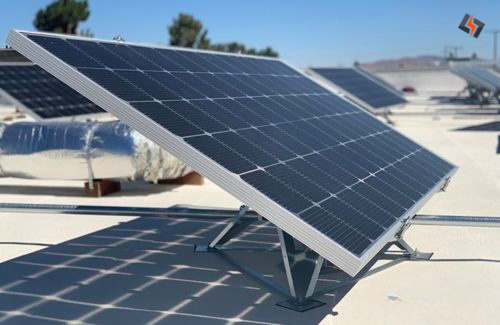SOLAR OFF GRID/ONGRID/HYBRID SYSTEMS
a)On-Grid:An on-grid solar system, also known as a grid-tied solar system, is a setup where your solar panels are connected to and work in tandem with your local utility’s power grid. This means that when your solar panels generate excess electricity, it can be fed back into the grid, and when you require more power than your panels are producing, you can draw electricity from the grid. This arrangement is commonly used in residential and commercial settings and offers benefits such as potential cost savings, the ability to earn credits for excess energy production, and access to grid power as a backup during times of low solar production or high energy consumption.
b)Off–Grid :An off-grid solar system operates independently from the main power grid. It consists of solar panels, batteries, charge controllers, inverters, and other necessary components. This setup is commonly used in remote areas or locations where connecting to the grid is not feasible or economical.

Solar panels capture sunlight and convert it into electricity, which is then stored in batteries for use during times when the sun isn’t shining. Charge controllers regulate the flow of electricity between the solar panels and batteries to prevent overcharging. Inverters convert the stored DC (direct current) electricity from the batteries into AC (alternating current) electricity, which is used to power appliances and devices.
Since off-grid systems rely solely on solar power and stored energy, careful planning is essential to ensure that the system can meet the energy demands of the location. Off-grid systems are commonly used in cabins, remote homes, RVs, boats, and other areas where access to the grid is limited or nonexistent.
c)Hybrid: A hybrid solar system is a combination of both on-grid (grid-tied) and off-grid (stand-alone) solar systems. It is designed to provide greater flexibility and reliability by incorporating the advantages of both types of systems.
In a hybrid solar system:
- Solar Panels: Like any solar system, it starts with solar panels that capture sunlight and convert it into electricity.
- Battery Storage: One of the key features of a hybrid system is the inclusion of battery storage. This allows you to store excess solar energy generated during the day and use it during the night or when the sun isn’t shining. Batteries also provide backup power during grid outages, similar to an uninterruptible power supply (UPS) system.
- Grid Connection: A hybrid system is still connected to the main power grid. This means that during periods of low solar production (such as cloudy days) or when your energy demand exceeds your solar generation, you can draw power from the grid. Conversely, if your solar panels produce excess energy, you can feed it back into the grid and potentially receive credits or compensation from your utility company.
- Hybrid Inverter: A hybrid solar system uses a specialized hybrid inverter. This inverter manages the flow of electricity between the solar panels, batteries, and the grid. It can switch between grid-connected mode, battery storage mode, and backup power mode seamlessly.
The hybrid solar system offers the advantages of grid-tied systems, such as potential cost savings through net metering, while also providing the resilience of off-grid systems through the use of battery storage for backup power. This makes it suitable for areas with unreliable grid power or regions where utility costs are high. It’s a versatile solution that optimizes the use of solar energy while providing a safety net during power disruptions.

